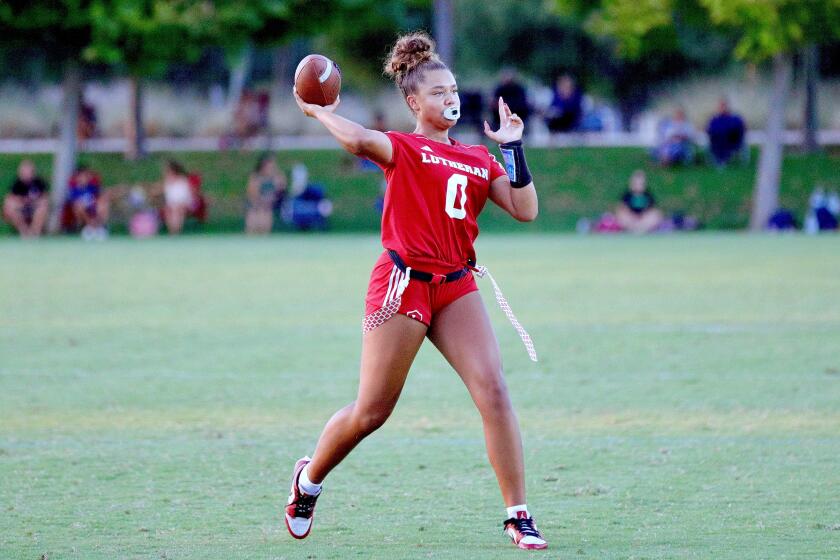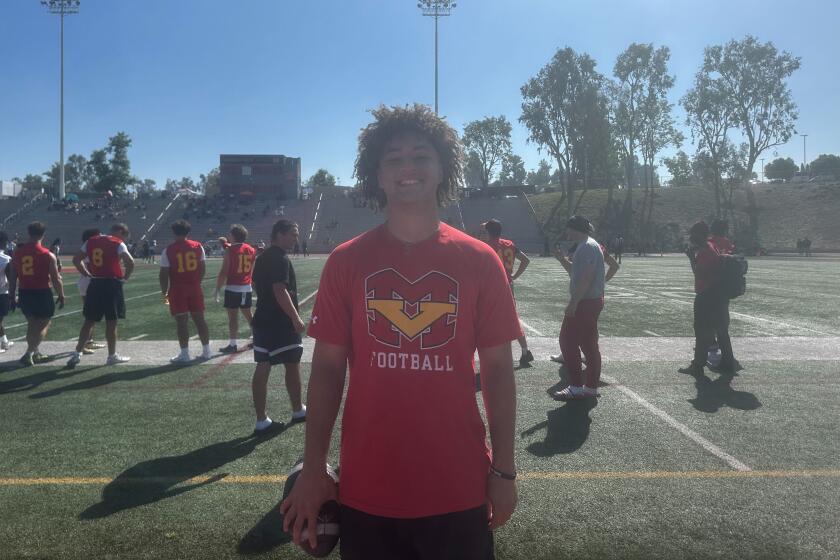It was 20 Years Ago : In 1975, El Dorado’s Boys and Santiago’s Girls Won Southern Section Basketball Titles : The El Dorado Golden Hawks
- Share via
PLACENTIA — There are 116 banners hanging on the gymnasium walls at El Dorado High School. Dressed in gold and trimmed in black, all are a testament to a rich athletic tradition.
Two are very special.
They represent the first Southern Section championships won by a team from El Dorado, courtesy of a terrific boys’ basketball squad coached by a man of perpetual slogans and energy. They are also the only two boys’ basketball titles El Dorado has won.
The memories are stamped deep into the psyche of those who were part of it. And they are stirred this time of year, when the Southern Section playoffs are front and center.
“Oh yeah, (the championship) is what everyone plays for,” said Kevin Heenan, the shooting star of both teams. “In the playoffs you never know what can happen. And for us to win two years in a row, well, you’ve got to have some breaks go your way. But every March, around playoff time, I always look back on it. Our teams always seemed to have good success.”
Dave Sherbeck, the point guard of the 1973-74 squad (and whose brother Eric was on the 1974-75 team), said the group of players assembled by Coach Nash Rivera is what made the experience unique for him.
“For me, it was being with a team, because I had played an individual sport all my life,” said Sherbeck, who is now the teaching pro at the Newport Beach Tennis Club. “I wouldn’t have traded anything for that experience. The other guys, the chemistry being so good. . . . Everybody always played all out. Things gelled so well.”
The Golden Hawks then were identifiable by three things: their haircuts, skinny legs and suffocating zone press.
In an era of flowing locks, they began each season with flattops and buzz cuts. At a time when weight training wasn’t required or expected of prep athletes, none of the starters weighed more than 175 pounds. Defensively, the Golden Hawks were more like starving piranhas, ravaging all who crossed their path.
Just as integral to their success was the understanding that every El Dorado player had a responsibility and accepted it.
“This group was so amazing. They all completely believed in the team concept,” Rivera said. “I always tell people it’s not what you believe, but what you can convince the players will work. I could always communicate with the kids, demonstrate what I wanted. And if they wanted to put in the time to improve, I was always available.
“I never had another group like that with as much team cohesiveness.”
Heenan agreed.
“It’s the old story about the chain being as strong as its weakest link,” Heenan said. “And all of us were committed to winning. I’m not just saying that.
“It was a unique situation. Everyone was happy to be a part of that program. Because they knew if they weren’t, Nash would tell them to take a hike.”
In a way, Rivera was lucky to be a part of it.
He had been at El Dorado since the school opened in 1966. After three seasons, he thought the team was ready to compete in the Orange League.
“I thought the first breakthrough year would be the 1969-70 team; at worst 12-12, maybe 14-10,” Rivera said. “But we go 5-19 and I almost quit coaching. I really began to question myself, question whether I could sell young people on my philosophies.”
Rivera decided never again to relax his standards.
“After that summer, I came back and felt if I was going to go down, I would do it with the things I believed in--hard work, total team concept,” he said. “Young people need direction and guidance; physically they can be mature, but they do not have the experience.”
So Rivera, in effect, started over.
The first step was haircuts. The players got two--before the first day of practice and before the first day of league. “It identified them for basketball and got them thinking basketball,” Rivera said.
Next came his team’s style of play. Before, Rivera had orchestrated every move. That worked reasonably well against average teams, but the Golden Hawks usually lost to the good ones.
“I didn’t have many gifted athletes,” Rivera said. “And they were not aggressive by nature. You play within the rules but you have to be competitive. And I figured the only way we could be competitive with the good Orange County and inner-city schools was to play a more up-tempo game.”
With help from assistants Iran Novick, Larry Hoekman and Terry Conley, Rivera revamped the program.
“It started with full-court pressing. It made us play faster. Before, if teams pressed us, we couldn’t run. I realized it was easier to slow teams down than speed them up. But I also began to trust kids more. Before I had tried to control everything.”
The El Dorado players weren’t the biggest or strongest, but Rivera would make sure they were quick and tireless. Their biggest weapon would be a 1-2-1-1 full-court zone press--a hybrid of the systems used by UCLA’s John Wooden and Katella High’s Tom Danley, two men Rivera greatly admired--that forced teams into mistakes or play at a tempo faster than they wanted.
And practice. Lots of it.
“Our kids believed in our practices,” Rivera said. “They were two hours long, but every minute was accounted for. I believed in the KISS theory--Keep It Simple, Stupid. There are no secrets in basketball. We focused on ball-handling, passing and catching; you always appear faster passing than dribbling. And passing promotes unselfishness.”
The dedication to excellence became infectious. Sherbeck remembered when he and team captain Jim DeWeese persuaded a swimming coach to let them have a key to the gym so they could practice shooting on Sunday before their first league game on Tuesday.
“An alarm went off, the police came in and arrested us, and we were suspended from school for a day,” Sherbeck said.
Another player from that group, Tyrone Branyan, said the look of the team was another ally. Reggie Ray was the only black player, and most opponents had the preconceived notion El Dorado couldn’t play.
“We looked pale and anemic because we were all gym rats,” Branyan said from his home in Cushing, Okla. “But we practiced hard and the games were fun. Maybe easier.”
The seeds of preparation began sprouting in the 1971-72 season. The Golden Hawks won 23 games, began a run of five consecutive Orange League titles, and reached the Division II-A semifinals.
“Those guys actually had more talent but they played against some better talent,” Sherbeck said.
By 1973-74, the pieces--starters Heenan, Sherbeck, Branyan, DeWeese and Bob Farra--fit perfectly. Even in the age before the three-point shot, the Golden Hawks averaged 69.9 points and held opponents to an average of 49.7. A year later, the numbers rose to 84.7 and 63. In one game against Fullerton, El Dorado scored 13 points in less than a minute.
“We kept the tempo up, knowing the defense could turn the game at any time,” Rivera said.
The coming-out party for the 1973-74 team was its season opener against Troy, which had one of the county’s all-time great basketball players in Mark Wulfemeyer. He scored 50 points, but the Golden Hawks won, 106-96.
El Dorado did not hit its stride until league play, however. But after losing to San Clemente, the Golden Hawks won 18 in a row, including the Division 2-A championship game against Agoura, 80-76, in overtime. Sherbeck helped the Golden Hawks get to the extra period by making four free throws in the final minute. They finished 22-6. Heenan and DeWeese each averaged 18 points and Branyan 14.
“It took the whole season for us to realize that we were as good as we were,” Branyan said. “But winning builds confidence. And that press . . . became like a feeding frenzy. We attacked teams with the intent to steal the ball.”
After the title game, El Dorado Principal Marv Stewart had his team cut down the nets. When told by Southern Section officials that he would have to pay for them because there was still another game to be played, Rivera said Stewart whipped out his checkbook and said, “Here’s the money for this year and next year, because we’re going to cut them down next year, too.”
Rivera cringed at Stewart’s brashness, but the principal’s words proved prophetic.
El Dorado won its first 15 games in 1974-75, running its winning streak to 33 before Brea Olinda beat El Dorado, 76-74. The Golden Hawks won the Orange League title again with a 12-3 record, and capped their 22-5 season with a 67-55 victory over Culver City in the Division 2-A final.
“I really felt then the championship game was in the semifinals against Brea Olinda,” Heenan said. “It was the fourth time that year we played them. A real tough game. They were big and they were good. The difference? I think our press and our conditioning. You know how a press works; you do it for a half a game, three-quarters of a game and suddenly it just clicks. Not to degrade our game against Culver City; they, too, were a good team and they hung in there.
“But once we beat Brea we knew we were destined. We thought Brea was the second best team in CIF. And there was that expectation we were supposed to win.”
Heenan played four years at Cal State Fullerton, where he was part of the 1977-78 team that came within a game of making the Final Four. (His future wife, Debbie Ricketts, played on the Fullerton women’s team.)
Branyan got a scholarship to Texas after a stint at Cypress College, where he was the state junior college player of the year.
Other members of El Dorado’s team were good athletes in other sports. Farra received a football scholarship to Cal State Fullerton. Sherbeck and partner Jane Stratton reached the quarterfinals in mixed doubles at Wimbledon in 1979.
They don’t gather much anymore. Heenan stays in touch with Branyan and Sherbeck, but at a recent 20-year class reunion, “Most of the team didn’t show up,” Sherbeck said.
That’s all right. Even after 20 years, few have forgotten their accomplishments.
More to Read
Get our high school sports newsletter
Prep Rally is devoted to the SoCal high school sports experience, bringing you scores, stories and a behind-the-scenes look at what makes prep sports so popular.
You may occasionally receive promotional content from the Los Angeles Times.






